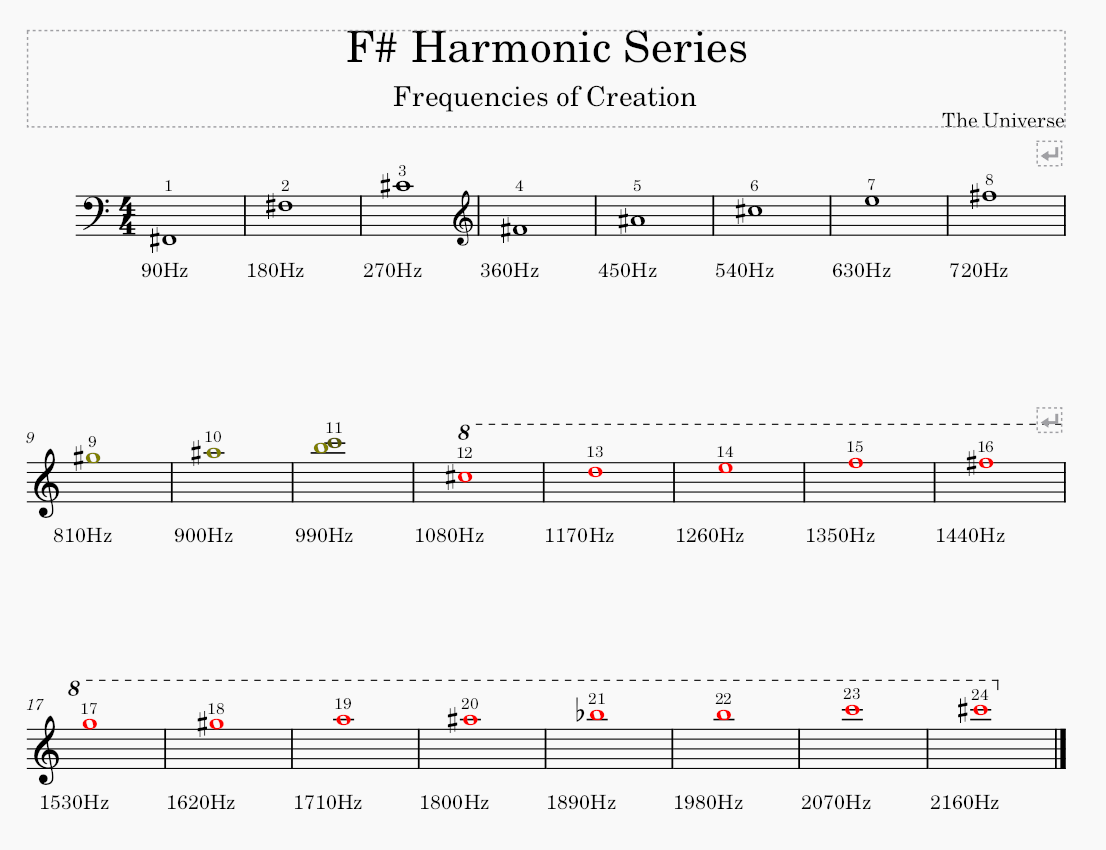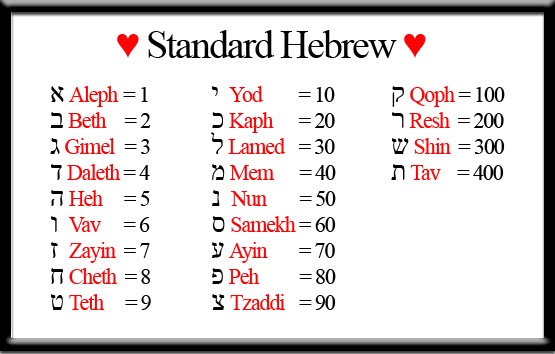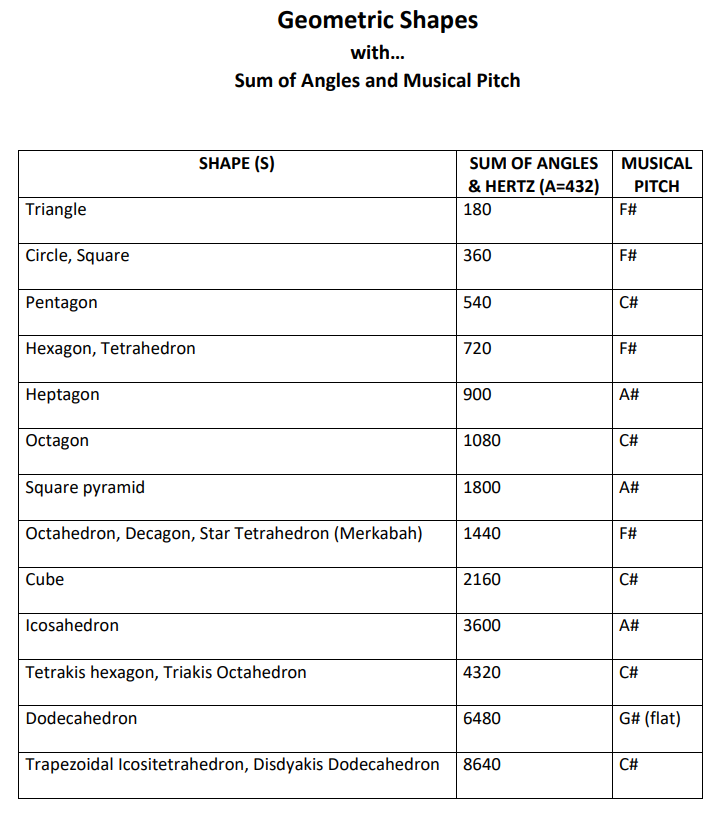Nikola Tesla said that "everything rings like a bell" and that "if you want to find the secrets of the universe, think in terms of energy, frequency and vibration." If it has a frequency, it can be translated to a musical pitch. Energy is a frequency, which means it can be converted to a musical pitch. Since everything rings like a bell, the universe is musical. It's with that premise I wrote seven articles (links at the end) explaining how creation is founded on musical laws that also coincide with the laws of nature.
Here, I present the "Cliff Notes" version of my seven Frequencies of Creation articles with minimal musical details. If you want the heavy theoretical musical stuff, you'll find the links to the seven Frequencies of Creation articles under the "sources" heading at the end of this article. The key? Look for patterns. When you find one, keep going down the rabbit hole!
How Creation Came to Be...

Everything has a resonant frequency from every color to the sound of water flowing down a river. "Matter" (objects) also have a resonant frequency. Thoughts, intents, and actions create a frequency. Nothing would exist without something holding things together. If we keep Nikola Tesla's quote in mind that everything in the universe is based on energy, frequency, and vibration, we begin to understand how we can explain the creation of the universe through music.
The Frequencies of Creation are found at the beginning of time. Creator spoke (which is a frequency) and stuff was created. We see this process through patterns in nature, mathematics, quantum physics, the human body, and much more. Eventually, all created things begin to resonate on wavelengths that work together like orchestral musicians playing their individual parts of a Beethoven symphony. The universe is meant to function harmoniously. That pattern of agreement is evident in math and music. We begin our journey by scratching the surface with a musical explanation as to how the universe came to be as spoken into existence at the beginning...
Music Theory Explains the Creation Process
Music theory is the study of how music works. It's the "quantum mechanics" of the music field where its natural laws are broken down, studied, and often only fully explored by geeky music theorists who often double as composers and often teach at the college level. Basic music theory is simple but to understand how the universe is musical, one must take a deep dive into high level music theory. For those who would rather get the simplified version, you're in the right place!
Let's start with some basic musical laws and terminology that people learn when beginning to study music.
- Notes: also known as musical "pitches." We measure musical notes in Hz or "cycles per second." As an example, A=440 is the A above middle C and it resonates at 440 cycles per second. Higher pitches have higher Hz numbers and lower pitches have lower Hz numbers.
- Scales: organized patterns of ascending and descending notes. Most common scales are Major, minor, Augmented, diminished, pentatonic, the various modes, etc. Scales are built using specific intervals placed in specific positions within a pattern of at least 5 ascending and descending notes.
- Chords: requires at least three notes (often more) that are played together at the same time. The most common chords are Major, minor, Augmented, and diminished.
- Fundamental Frequency: is often referred to simply as the fundamental and is defined as the lowest frequency (musical note or pitch) of a periodic waveform. In music, the fundamental is the musical pitch of a note that is perceived as the lowest partial present (what is heard by the ear).
- Harmonic Series: (or the overtone series) in music is a combination of all the notes (overtones) in one pitch. The harmonic series is part of the laws ruling nature. The intervals within the harmonic series are larger (wider) toward the fundamental (lowest pitch) and decrease in strength as the remaining higher frequency notes ascend into infinity.
- Interval: is the distance between two notes. Intervals are considered Perfect, Major, minor, Augmented, or diminished. They are identified by a letter followed by a number. Examples are P5 (Perfect 5th), m3 (minor 3rd), A4 (Augmented 4th), or d5 (diminished 5th).
- Key Signatures: tell a musician which notes to sharp or flat within a scale. On sheet music, key signatures appear at the beginning of each staff line.
The Musical Harmonic Series

Figure 1
The musical harmonic (overtone) series is the basis of all creation. In Figure 1, I created a chart based on the fundamental frequency of F#. At the beginning of time, a sound was heard. The waveforms are still in the cosmos and can be measured. By making the appropriate mathematical adjustment, scientist Mark Whittle says the note at the beginning of time was an F#. The next sound that came out of the F# was the interval of a minor 3rd. The minor 3rd then morped into a Major 3rd (M3).
This appears to be the only time in nature that something in creation doesn't follow the exact laws of harmonics. And, it's the first musical measurable event known to us at the time of this writing (2024). As mentioned above, the original sound at the beginning of creation was an F#. The intervals of a minor and Major third are evident at the lower end of the harmonic series (partials 4 - 5 and 5 - 6). When all three partials (4, 5, and 6) are sounded together, they build a Major triad. And, these intervals (M3/m3) make up the four most common chords in music: Major, Augmented, minor, and dimished.
In Figure 1, the first 24 partials for the harmonic (overtone) series with the fundamental set as the lowest F# on the piano are listed even thought there are many more beyond these 24. Notes above the fundamental sound as sympathetic vibrations at varying strengths depending on the instrument or voice. In music, we call this "timbre" and it helps our ears identify what instrument is playing or who is speaking. In a sense, every voice and instrument has it's own "voice print." The same musical instrument can sound slightly different depending on materials used (mouthpiece, body of instrument, reeds, bow, string type, etc.) and will produce slightly varied versions of that instrument's harmonic spectrum from performer to performer.
We can take this a step further because harmonics are evident in the creation of everything, including stuff outside the human hearing range. Remember that energy = frequency. If it has a frequency, it will have a musical pitch that comes with harmonics. The strength and weaknesses of the harmonics (overtones) are determined by the tone or "timbre" of an instrument, voice, or object that's creating the sound. We see this with colors in the periodic table. Scientists originally identified elements by their colors just like we identify musical instruments by the "color" of their tone (timbre).
As I mention in the first two articles of the Frequencies of Creation series, it seems odd that the lower notes of the harmonic series aren't evident in the initial F# at the beginning. But then... I discovered the musical frequencies of the Hebrew letters in 2018. After first watching Whittle's presentation at the World Science Festival in 2014, I thought nothing of it until I discovered the voice of Creator is represented by a minor 3rd and the voice of Yeshua is represented by a Major 3rd. In 2018, I realized that musical intervals play a major role in HOW things within the universe are/were formed. We also see these two intervals in Russell Smith's musical frequencies of the periodic table of elements. Whittle specifically states the first harmonic heard out of the big bang (from F#) was a minor 3rd that morphs into a Major 3rd. Those notes are F# - A which morphs from an A to an A#. Or, it's possible Whittle meant the first interval was F# - A (minor third) and from the second note (A), a Major 3rd came next. If that's the case, A - C# is a Major third. The two intervals together create an F# minor triad (F# - A - C#) which are highly prevalent notes in human DNA. What are the odds of that?
F# is Found Everywhere!
In Figure 2, notice that each Hebrew letter is assigned a "gematria" number (AKA, numerology). When using the gematria for the final forms of five Hebrew letters, I found that by turning the gematria into Hz frequencies, the musical harmonic series is present. Not only that, but the last note/letter (Final Tsadi) leads to a return back to the beginning (Aleph), which aligns with cyclical Hebrew thinking. Based on current research, the Hebrew culture is the first to use numerology. Therefore, it appears that the Hebrew letters were inherently designed according to the musical harmonic series. What are the odds of that?

Figure 2
We must remember that math is music and music is math. If there's a number, it can be turned into a Hz frequency. Whether those numbers mean anything or not depends on the presence of a pattern. When turning the gematria numbers of the Hebrew letters into Hz frequencies, I found the pattern of the musical harmonic series. Therefore, I knew it had to mean something. Throughout my research into the Frequencies of Creation, I search for connections between numbers and musical pitches. When I find something that intrigues me, I determine if the numbers/musical frequencies fit within the laws of nature and if patterns and/or cycles are present.
Here are some other connections I've found when taking numbers and and turning them into musical frequencies. Many things on this list are fully spelled out musically in the Frequencies of Creation articles. They line up with the various F# scales (Major, minor, and modal) which I believe is probably not a coincidence:
- F# is a major component in human DNA. (Frequencies of Creation: Part 3)
- Many ancient megalithic sites, including the Great Pyramid, have "standing resonances" that are centered around F#.
- Crop circle measurements of angles and arches align with notes found in F# scales.
- Platonic solids and other geometrical shapes are related to the F# harmonic series.
- The 7 Divine names of God (Frequencies of Creation: Part 6) follow the interval pattern (M3 and m3) that came out of the sound "at the beginning." This is based on using the specific musical pitches of each Hebrew letter within each name.
- The periodic table of elements (Frequencies of Creation: Part 7) is based on the intervals of Major 3rds and minor 3rds with many notes falling within the F# scale and other closely related "keys signatures."
- As stated in Part 2 of the Frequencies of Creation series, "at the beginning was a sound. Out of that sound, the voice of Yahweh was heard, which then morphed into the voice of Yeshua. Together, they began the creative process."
F# in Geometric Shapes
There are many connections between the key of F# and stuff within creation, starting with the first Divine name of God - Yod, Heh, Vav, Heh (Yahweh). From there, the patterns spill into nature. As mentioned earlier, we even see how notes within the F# scale are found in shapes (Figure 3).
Although I don't mention the Schumann Resonances in the Frequencies of Creation Series, they, too, fall within the scope of the F# scale (A=432 concert pitch). 7.83 Hz is close to a B and B is the 4th note of an F# scale.
When looking at entrainment (a process where two rhythmic systems interact and eventually synchronize their phases or periodicity), it only makes sense that what's in nature will synchronize. This is the process of "entanglement" for all things within the universe.

Figure 3
Final Thoughts...
I'll end this article the way I began it... when a pattern is found, go down the rabbit hole! Look for patterns, cycles, and connections when studying how creation fits together through synchronicity. Entrainment and entanglement demonstrate that the first sound "at the beginning" created a tone that all of creation could come into alignment with. I will venture to state that sound is the voice of Creator that continues to fill the universe today. Through the minor 3rd, that voice is solidified where Yeshua is introduced in the Major 3rd. These two musical intervals set the stage in how the creation works.
It's implied but not actually mentioned earlier that frequencies within nature appear to "rest" within the A=432 concert pitch. The F# that was heard "at the beginning" is actually closer to an F# in the A=439 concert pitch. But honestly, that doesn't seem to matter as much because pitch can be greatly adjusted within every concert pitch so intervals are in tune. The laws of harmonics allow for natural tuning as needed between intervals depending on where pitches fit within a chord. Notes are "tempered" for tuning purposes. We can only assume that nature follows suit.
The musical intervals that came out of the beginning are the easiest ones to sing (according to music teachers) and naturally fit within the voice. The interval of the minor 3rd is the main interval sung by most civilizations as well as young children when they begin to sing. This is probably one reason the pentatonic scale has been around for thousands of years. It seems we were created to easily sing and tone the most Holy name of God (Yahweh) which is spelled Yod, Heh, Vav, Heh in Hebrew and produces the interval of a minor 3rd. Many call this the "tetragrammaton."
The bottom line is that once something is created, or initiated, everything else comes into alignment (entrainment) with the original "voice." In music, it's the fundamental frequency with harmonics that "color" the tone of that frequency. Quantum physics describes this process as entanglement. According to Caltech Science Exchange, entanglement occurs when "two particles, such as a pair of photons or electrons, become entangled, they remain connected even when separated by vast distances. In the same way that a ballet or tango emerges from individual dancers, entanglement arises from the connection between particles. It is what scientists call an emergent property."
In closing, it appears everything in the universe desires to come into agreement with the original frequency that came forth "at the beginning." This is done through entrainment and entanglement and may appear at times as a "musical wrestling match" while frequencies tune with one another. This is evident in the periodic table of elements because tuning successive Major 3rds eventually adjusts the concert pitch. Therefore, we shouldn't be concerned with the variety of concert pitches people suggest (A=432 vs A=440 vs A=444, etc.). They are ALL good because "pitch adjustments" between intervals are part of nature.
Del Hungerford, 2024
NOTE: None of the information in this series or any other article on this site may be used without permission! You may share the articles but if you wish to quote my work in your own writing, it is "good form" to cite any materials that aren't your own.
Sources
Listed below are the articles in the Frequencies of Creation Series. Sources are all found at the bottom of each article. Click each link and scroll to the bottom for materials discussed in each article. As an academic, I provide any research found from outside sources. Musical materials mostly come from my days as a college professor in music, unless otherwise noted.
- Frequencies of Creation: Part 1 (discovering patterns).
- Frequencies of Creation: Part 2 (the "God" interval and note)
- Frequencies of Creation: Part 3 (DNA connects with nature)
- Frequencies of Creation: Part 4 (the power of F#)
- Frequencies of Creation: Part 5 (the power of musical intervals)
- Frequencies of Creation: Part 6 (Divine names of God)
- Frequencies of Creation: Part 7 (The periodic table)

